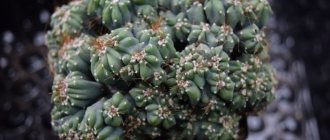Caring for cacti at home
After purchasing a cactus, it is important to provide it with optimal conditions for growth and development. They can be very different between desert and tropical varieties, but are fairly similar in most succulents.
Temperature
Optimal air temperature for cacti: +25...35 °C in summer and +5...10 °C in winter. Most species tolerate extremes of heat and cold well. Temperature disturbances slow down growth, but rarely lead to problems or death of succulents.
Lighting and location
Desert cacti need plenty of sunlight. They need to be kept in well-lit places, preferably on south, south-east or south-west windows. But forest varieties dry quickly in such conditions, so they should be placed in the shade on a northern, western or eastern window sill.
It is not advisable to move or rotate cacti.
If it becomes necessary to move a plant, make a mark on the pot so that in the new place it stands with the same side to the sun as in the old one.
Watering
The humidification mode must be selected depending on the type of cactus. Desert succulents can go without water for months, while tropical ornamental varieties require deep weekly watering. Plants quickly rot if there is excess liquid, so after each procedure it is necessary to wait until the soil is completely dry.
For irrigation, it is best to use filtered rainwater. Liquid from wells and springs is not suitable because it is too hard.
Chlorinated tap water must be settled and filtered through peat or activated carbon. To soften it, you can use a solution of oxalic or acetic acid (dilute 5 ml in 1 liter).
In spring and autumn, it is advisable to water succulents in the morning, and in the hot summer months - in the evening. This will allow the moisture to be absorbed into the roots of the plant without drying out. If the cacti are in a dusty room, they need to be additionally sprayed with a spray bottle.
To prevent stagnation of moisture in the soil, you need to regularly clean the drainage holes of the pots.
Fertilizer
Cacti do not need fertilizer. Plants do not tolerate most fertilizers well, so they are used only to save weakened or sick specimens, as well as in case of a long (more than 5 years) absence of flowering.
Rules for choosing a mixture:
- a minimum amount of organic components (they have a bad effect on the health of succulents);
- absence of nitrogen, which causes rotting and death of cacti;
- mineral component (calcium, phosphorus, magnesium in small quantities).
1 plant requires 5-10 g of fertilizer, depending on its size. The mixture can be used no more than once every 2 months.
Description of the cactus
Cactaceae are a family of perennial succulent plants from the order Caryophyllales.
Divided into four subfamilies. The most numerous genus is Mammillaria.
The word "cactus" comes from the Greek. κακτος, which in classical Greek was used to designate a type of thistle. Carl Linnaeus introduced the word as the name of the genus Cactus in 1737 in his early work Hortus Cliffirtianus, most likely as a shortening of the word melocactus, which was widely used to refer to these plants at the time - choosing thistle as a suitable name for plants known for their thorns. Today this word is used in botany to name the family Cactaceae.
Cacti are plants of the New World, that is, those that originate from South and North America, as well as the islands of the West Indies. In addition to America, the species Rapsilis barrenus is also found in Africa, Madagascar and Sri Lanka, where it is believed to have been brought by migratory birds.
In addition, humans have spread some types of cacti - mainly prickly pear - to all continents except Antarctica. The Opuntia creeping species is widespread throughout the Mediterranean and is found on the coast of Crimea, as well as in the south of the Volga region.
How to replant a cactus
You need to replant succulents when they become cramped in an old pot. For young plants, it is advisable to carry out the procedure annually, for old plants – every 3-4 years. Timely and correctly carried out replanting has a beneficial effect on the health of the plant by renewing the soil and expanding the space.
Pot
The container for replanting should be 2-3 cm larger than the one in which the cactus grew before. There should be enough space for the plant's root system, but not too much: empty space is bad for succulents. It is optimal that the container size is 50% larger than the diameter of the roots, and the depth is 20% greater than their length.
You can choose pots of any shape and color, but they must have drainage holes at the bottom: otherwise moisture will begin to accumulate in the container, which will cause the plant to rot.
Young cacti prefer plastic containers that prevent soil leaching. Mature plants grow best in ceramic and clay pots.
Earth
You need to fill the pot for transplanting as follows:
- Fill the bottom with drainage mixture to 1-2 cm.
- Place some substrate on top.
- Leave the remaining layer underground. It should fill the pot without reaching 1 cm to the edge.
For optimal growth, desert cacti require loose, slightly to moderately acidic (pH 4.5 to 6.0), porous soil with good water permeability. The optimal composition of the soil mixture: leaf and turf soil, charcoal, washed river sand.
For succulents with white needles, add a little gypsum. Peat should be used carefully when growing cacti: it promotes plant growth, but slows down the processes of reproduction and flowering.
The choice of soil mixture depends on the plant variety. Unpretentious varieties, such as Echinopsis, grow well on a mixture of any soil and sand in a 1:1 ratio. Tropical cacti prefer clay substrate.
How to transplant
It is advisable to replant in the spring, when succulents begin their active growth stage. 2-3 days before the procedure, stop watering the plant so that the soil dries out and begins to fall freely from the roots. It is advisable to disinfect a new pot for a cactus by pouring boiling water over the inner and outer parts: this will protect it from diseases and parasites.
If the cactus is prickly, replanting is carried out wearing thick fabric gloves, and the plant itself is wrapped in several layers of newspaper, polystyrene foam or foam rubber.
Stages of work:
- Take the pot and turn it over. Using a thin stick or pencil, lightly press the soil inside the pot through the drainage holes so that the earth ball falls out.
- Shake off the root system from the remaining soil. If the plant is transplanted into a new soil mixture, it should be completely washed and cleaned.
- Trim overgrown roots. Treat the cut areas with charcoal.
- Place the plants in the pot, being careful not to wrap or bend the roots. Cover with substrate, but do not cover the bottom of the stem.
After replanting, it is recommended to compact the soil - sprinkle with pebbles or small crushed stone.
How to care after transplant
After transplantation, the cactus is placed in a quiet, shaded place. Humidification is stopped for 4-5 days, then watering is gradually resumed, starting with 20-50 ml of water per day. If necessary, it is alternated with liquid mineral fertilizers.
Types of cacti
Astrophytum
They grow quite well. Their distinguishing feature is the white flakes on the outside of the ribs. The flowers of this variety of cacti are yellow.
Astrophytum asterias
This small cactus is gray-green in color, becoming white-green closer to the trunk of the plant. Bright yellow flowers with red centers appear around the fifth year. In winter, when the plant's growth process has practically stopped, the saucer-like cactus shrinks to a flat disk.
Astrophytum capricorne
This gray-brown cactus species looks like a small mountain. Quite often, the flowers of this variety of cacti, or rather their core, are painted wine-red.
Astrophytum myriostigma
This cactus is spherical in shape and has a tiny white “cap” at the top, which is how the cactus gets its name. The color of its stems is usually brown; the flowers of this variety of cactus are yellow.
Ferocactus
Ferocactus has quite hard, scary-looking, long and decorative spines. Generally, this type of cactus is cylindrical in shape and the height of this cactus is approximately 5-6 inches. Often “babies” appear near the main trunk. On older specimens, large flowers appear in summer.
Ferocactus cylindraceus
The long, hooked, bright red spines of this cactus variety become dense over time. This type of cactus has flowers that are usually orange and yellow.
Broad-needle ferocactus, Crow's Claw cacti (Ferocactus latispinus)
With age, the red spines become wider and more hooked. The mature plant reaches approximately ten inches in height and fifteen inches in width. Flowers typically appear in purple and cream colors in the spring.
Ferocactus purple (Ferocactus wislizeni)
This cactus is characterized by its red and white spines and yellow, orange or red flowers. The cactus is quite demanding; excessive watering should not be allowed, and it also does not tolerate drought quite well.
Opuntia
This type of cactus grows quite well. A mandatory precaution when handling this type of cactus is thick gloves; you can even use leather gloves, since the spines of this plant are very sharp. The peculiarity of this type of cactus is that tiny prickly bristles grow all over the stem. It is these bristles that can cause much more pain than the spines themselves, since you may not notice them (the bristles).
You can see these plants in various variations - flat or oval; cacti are characterized by quite large sizes. The flowers of these plants are extremely showy. They bear colorful, edible pear-shaped fruits, which is how the species gets its name. Quite a few species of these cacti are very hardy, so these species can be planted in open ground.
Opuntia microdasys
The mature plant is characterized by a height of two feet and approximately the same width, the round stems of this cactus give the impression of velvet, in addition, the stems of this plant are very green. As a rule, this variety of cacti has bright yellow flowers.
Opuntia polyacantha
A mature plant of this species is characterized by a unique shape, which is complemented by a variety of white spines.
Echinocereus
Small spherical cacti, as if covered with short spines, they are also characterized by beautiful flowers. I would like to note that this type of plant blooms quite often. These cacti are easy to grow, so they are often recommended for beginner plant growers.
Echinocereus triglochidiatus
This type of cacti is characterized by fairly large spines, and in summer these cacti delight with brilliant scarlet flowers. When mature, they can grow up to two feet wide.
Echinocereus rigidissimus
The short spines of this small, bushy cactus can be striped red and white. A ring of pink and fuchsia flowers appears at the top of each stem. A relatively young plant will delight you with flowers.
Mammillaria
Snow white mammillaria (Mammillaria candida)
This small cactus itself, which often grows in clusters, is hidden in dense white needles, which quite often have a pink tint. Typically, this type of cactus produces flowers in the spring. Interestingly, at first when the flowers bloom they are the color of cream and then turn pink.
Mammillaria bocasana
The cactus grows as a bush, its spherical blue-green stems covered with short, dense needles. As a rule, this variety of cacti has small flowers, white or yellow.
Mammillaria hahniana
This cactus usually grows alone and is spherical in shape with short, dense, white hair and purplish red flowers.
Mammillaria zeilmanniana
This cactus is characterized by red-purple flowers, the stem of each plant itself is covered with white hairs. By the way, this type of cactus grows mainly in groups.
Parodia chrysacanthion
Mature plants are covered with golden spines, but young cacti are distinguished by dense white hairs. As a rule, in spring and summer this variety of cacti pleases with small yellow flowers.
Cereus uruguayanus
These upright cacti can grow up to three to six feet indoors. The plants are smooth, blue-green in color with brown spines. As a rule, the flowers of these plants open at night; white flowers are quite common.
Echinocactus Gruson (Echinocactus grusonii)
The vertical barrel-shaped green trunk is covered with heavy golden-yellow needles. As a rule, this type of cactus has golden-colored flowers. Quite often, novice plant growers start this particular type of cactus.
Carnegia gigantea
This is a fairly well-known species of cactus that can often be found in films. This type of cactus has a thick trunk and leaves that grow in different directions; the leaves somewhat resemble hands. In spring, this cactus pleases with white flowers. When the plant is still young and therefore small in size, this type of cacti grows very well in pots.
Gymnocalycium
These small, compact cacti are ideal for potted life on windowsills and in areas where space is limited. If the plant is young, then it will delight you with flowers quite often. As a rule, this type of cacti has white or pink flowers, sometimes you can find cacti of this species with red flowers.
Escobaria
These cacti often form large groups, they bloom quite often, and, what is no less pleasant, they are not very difficult to care for. In many varieties of these cacti, the needles are elongated and relatively soft. It is thanks to this feature that the plant appears hairy.
Echinocereus triglochidiatus. © Andy Blackledge
Caring for cacti during flowering
During the flowering period, succulents do not require complex care. Watering varieties such as epiphytes and prickly pears continues in the standard mode. Desert heat-tolerant cacti, such as cereus, are moistened with a sprinkler. If there is an excess of moisture, the flowers quickly begin to fall off, so you need to carefully control the amount of incoming water.
It is not advisable to feed and plant succulents during the flowering period.
What to do if the cactus does not bloom
The reason for the long absence of buds is most often a violation of the temperature regime. Before flowering, the cactus must spend the winter away from heat and sun. At this time, restructuring begins in its tissues, preparing the plant for growth and reproduction. If you do not provide it with such “hibernation”, the necessary processes will not start and flowers will not appear, therefore it is important to follow the rules of wintering.
Sick, weakened succulents also bloom poorly. The problem can be solved if you promptly treat them with medicinal products and feed them with fertilizers. But you should not apply such measures to healthy plants: this can lead to excessive growth, stem deformations and other inconveniences.
In many cactus varieties, buds appear only after reaching the desired age or size. Some varieties have a ripening period of more than several years, which is also worth considering if they do not bloom.
Video description
In this video, watch the 10 most beautiful cacti for home breeding:
See also: Catalog of companies that specialize in garden houses and landscape design.
Rhipsalis
Soft woody succulents come from the rainforests of Brazil. They have a large number of stems that hang down in cascades. These cacti grow very quickly, and with proper care you can get a beautiful and voluminous indoor plant in a few years. The rhipsalis genus has more than 60 species, and a very small number of species can be grown at home.
Rhipsalis Barchela has thin cylindrical shoots.
This type of cactus will perfectly complement any composition in the house Source klumba.guru
Rhipsalis hairy is distinguished by thin and long shoots that not only branch, but also twist a little. At the end of autumn, the shoots are covered with small white flowers.
Really resembles hair Source prorostet.ru
Rhipsalis elliptical is a bit like a Christmas tree, but its buds form along the edges of the leaf blades. Flowers painted light yellow.
It should not be confused with the Christmas tree Source worldofsucculents.com
Rhipsalis pilocarpa is distinguished by powerful shoots of a dark green hue, covered with long hairs. Buds form on the shoots several times a year. The flower is white with a slight yellowish tint and has a large number of stamens.
Wonderful home decoration Source i.ytimg.com
Multicolored cacti
Cacti are plants that are susceptible to mutations. Sometimes shoots grow from seeds that do not have chloroplasts - cellular organelles containing chlorophyll.
As a result, the plant not only has an orange, pink or yellow color, but also cannot survive on its own, since it is not able to produce the necessary substances when exposed to sunlight.
In other words, the process of photosynthesis is impossible for such specimens. But, if such a plant is grafted, the rootstock will feed such a plant. For the first time, such experiments began to be carried out in Japan, which is why such cacti are sometimes called Japanese.
Under natural conditions, these cacti die Source i1.wp.com
Almost all types of cacti have seedlings with a mutation without chlorophyll. But the most widespread species are those that grow quickly and have a tendency to reproduce vegetatively, that is, they form many additional children.
The most unpretentious varieties are used for the rootstock Source flowers.evroopt.by
For such plants there is no need to create special conditions - the main thing is that the rootstock is alive. They can be successfully used to decorate any interior or create various compositions.
Each composition is unique Source krrot.net
Wintering a cactus
In winter, succulents need coolness (optimal temperature is 5-12 °C) and rest. During this period, the plant stops growing and prepares for future expenditure of energy on flowering and reproduction. The dormant period lasts 2-3 months, after which spring growth begins.
Rules for preparing for wintering:
- Before the rest period, it is necessary to reduce watering of the plant. They begin to do this in the fall, reducing the amount of water as the temperature and light intensity naturally decrease.
- When the plants are on the windowsill, they need to be protected from the heat of the radiators using plexiglass or other heat-insulating material. If this is not possible, the pots will have to be moved to a more suitable location.
- Do not let the temperature drop too much. Cacti do not tolerate frosts and drafts well, so if necessary, it is worth insulating the window frame with a layer of thick fabric or polystyrene foam.
A hibernating cactus should not show any signs of growth, including tilting towards the light. If the plant breaks dormancy, you need to return it to a room with a high temperature and resume watering, otherwise it will dry out and shrivel.
Varieties of cacti
Cacti are divided into two groups:
- forest cacti, which are native to tropical forests.
- desert cacti, whose natural habitat is hot semi-desert.
The requirements for their care differ depending on what species the cactus belongs to. Desert cacti thrive in full sunlight, unlike the flatter cacti. You can place them on south-facing windows, and practically do not water them in winter. Forest cacti, on the contrary, in summer need to be hidden from the sun's rays.
Cactus propagation
Growing succulents in houses or apartments is quite easy. To do this, they use 3 main methods, each of which is worth considering in more detail.
From seeds
This type of reproduction is not in demand, as it takes a lot of time. Most often it is used by professional flower growers to grow rare species and develop new varieties. The seeds are soaked in a solution of potassium permanganate for 1 day and evenly laid out in a pot on leveled soil, then moistened, covered with glass and placed in a permanent place.
The optimal temperature for growing is 25-40 °C. The soil with seeds must be constantly kept moist by spraying it with a spray bottle. After germination, the glass is removed and the pot is transferred to the sun.
Cuttings
This type of propagation is used in species with long, not too thick stems. The top of the cactus (at least 2 cm) is cut off with a sharp knife, previously disinfected with alcohol. The cuttings are placed on paper and left to dry in a dark, cool place for 3-4 days.
When it dries, prepare a pot: drainage is placed in it and soil is filled, and 2-3 small flat stones are placed on top. The future cactus is placed on them, cut side down, making sure that it does not touch the substrate. The container is placed in a place with dim, diffused light.
After 1-2 weeks, roots appear on the cuttings. When this happens, the stones are removed and it is replanted in the soil.
Children
The easiest way to propagate cacti is vegetatively. With a sufficient amount of nutrients, a mature plant will begin to form shoots (“babies”) from the areoles.
They are already formed succulents with their own tissues and systems, spines and skin. They can be separated from the main plant when their roots become visually visible.
The formation of shoots begins after the root system of the main cactus completely occupies the pot. Therefore, when propagating succulents in this way, you should not rush to replant.
The Legend of the Cactus
There are many legends about cacti, here is one of them.
Rose, tender and defenseless, once had a birthday. All the flowers prepared their gifts for her - petals with drops of dew. And only Cactus did not know what to do. “Rose is so beautiful! - he thought. “And I’m so clumsy, ugly with my thorns... no, it’s not her birthday for me...”
And Rose, it turns out, was sensitive and attentive; she seemed to guess Cactus’s sad thoughts and asked her friend Butterfly to tell him to be sure to come: after all, there is no gift more valuable than friendship. How happy Cactus was at the invitation!
“I’ll definitely come,” he said to the Butterfly.
And then Rose's birthday came. Accepting gifts from guests, she smiled at everyone tenderly and a little sadly. Cactus was the last to approach Rose.
“I wish you all the very best,” he said. “But you’re so defenseless, you’re so easy to offend, and that’s why your smile is always a little sad.” I’ve been thinking for a long time about what to give you... Here, take this... - and Cactus handed Rose a prickly fur coat.
“Thank you, dear friend,” Rose answered, “I really missed this fur coat.” But you are too modest - after all, it’s your birthday too. I haven't forgotten about it. Accept a gift from me too,” Rose handed him a fragrant white bud.
Since then, Rose has worn a prickly fur coat, and Cactus blooms on her birthday.
Cactus pruning
Cutting off excess parts of plants prolongs their life, stimulates growth, and promotes abundant flowering. Cacti are no exception: timely pruning will have a positive effect on the health of many varieties.
Is it possible to trim
Pruning cacti is legal and beneficial.
It must be done in the following cases:
- the appearance of rot;
- severe distortion, deformation of the stem;
- excessive growth.
Some ornamental varieties require regular pruning for normal functioning.
Rules
To prevent pruning from causing harm to the plant, you must adhere to the following rules:
- use only a disinfected knife;
- treat large and small cuts with crushed coal;
- After the procedure, place the cactus in the shade so that the wound can dry out:
- do not allow the cut to come into contact with the ground.
After pruning, you need to monitor the plant in order to notice signs of weakening or infections in time and take action.
Landing rules
The optimal time for planting is spring. But before you start, you need to prepare the container and substrate.
To plant cacti, containers made of glass, clay or plastic are used. In our opinion, collections of different varieties look impressive when planted in colored sand in an aquarium. The top of the composition can be decorated with multi-colored decorative stones.
The size of the container depends on the structure of the root system of the plant being planted. For vertically developing roots, choose deep and narrow dishes, and for horizontal ones, shallow and wide ones. Based on this, aporocacti will require a deeper container, and for mammillaria, which form many children, a wider one. There are no requirements for the shape of the pot. In our opinion, you should focus only on the interior of the apartment, so that the cacti fit harmoniously and become a bright decoration of the room.
Soil requirements
In our opinion, the composition of the substrate depends on the type of cactus. But there is a universal soil in which any member of the family will feel good. To prepare the drainage, you will need small pebbles, coarse sand, and for the substrate - small pebbles (85-90%) and forest soil (10-15%). Some species grow well in a simple soil mixture of turf soil and sand. But drainage is still needed.
The soil from the forest is first cleared of roots and debris, and then disinfected. An effective way is to bake in the oven for 20 minutes at a temperature of 200 °C. To prevent the development of diseases, pebbles are also treated: they are boiled.
Landing technology
When everything is prepared, proceed to the main stage of work. Sequence of steps:
- At the bottom of the pot, drainage is made from small pebbles, and the prepared soil mixture is poured.
- Make a hole in the center.
- Planting material is placed in it, carefully straightening the roots. The root collar should be flush with the ground.
- Sprinkle the roots.
- Distribute the soil mixture evenly by shaking the dishes.
- To ensure a natural microclimate, a top layer of small pebbles is made.
Then the cactus is watered. The plant is transferred to a permanent place of growth immediately, since cacti do not like rearrangements.
Diseases and pests of cacti
Cacti, despite their unpretentiousness, are susceptible to various diseases. It is easier to save a plant from them in the early stages of infection, so gardeners should familiarize themselves with the common pathologies of succulents.
The plant turns yellow
Yellowing of plants is most often caused by a lack of nutrients in the soil. Fertilizing, adding fertilizers, and replanting in enriched soil will help solve the problem. Less commonly, the yellow color of a cactus is a symptom of infection with the jaundice virus. This disease is incurable and leads to the death of affected specimens.
Rotting
Rot on cacti is most often a consequence of excessive watering and high humidity.
It can be a symptom of diseases such as:
- cactus late blight;
- helminthosporiosis;
- rhizoctoniasis;
- fusarium;
- black rot;
- anthrocnosis.
Rotting is most often caused by fungi, less often by bacteria. The treatment regimen is selected depending on the degree of damage and the specifics of the disease.
Doesn't grow
The lack of visible growth in cacti can be a sign of a variety of diseases and parasites: you need to focus on the accompanying symptoms. If there are no other signs of trouble, then the cause of slow development is errors in care: watering with cold water, lack of light, improper transplanting and rearrangement.
In addition, succulents naturally slow down their growth during the winter and after flowering.
Pests
Cacti are susceptible to infection by the following types of parasites:
- spider mites;
- root nematodes;
- aphids (leaf varieties);
- scale insects and false scale insects;
- mealybugs;
- felters.
Symptoms of pest infestation include drying out of the plant, slower development, and the appearance of white films and discharge on the surface. Sometimes you can see insects crawling on the surface of the cactus.
Cactus diseases
The most common problem is waterlogged soil, especially in winter. In this case, cacti are affected by various types of rot. Treatment of the plant involves removing it from the pot, rinsing the roots under running warm water, drying, then cutting off all soft and darkened roots, treating all stems and leaves with traces of rot with an antiseptic, then placing the plant in a new pot and not watering until it will not grow. Keep in a bright place, but not in the sun. Cacti can be susceptible to pests: shield aphids, spider mites, mealybugs.
Rate this post
Soil for cactus
An important soil requirement for a cactus is an indicator of its acidity. In gardening practice, they deal with pH values from 3.5 to 8.5. To maintain the slightly acidic soil necessary for cacti, they need to be watered with water with a pH of 4.5-6 or at least with a neutral pH of 6.4-7.3. The optimal soil acidity regime for cacti is within the pH range of 5.5-6.9. The pH of tap water is much higher, so by using such water, especially in summer with a high frequency of watering, we ourselves worsen the nutrition of our plants.
It is known for certain that damage to cacti occurs more often when the pH is too high than when the pH is too low. For epiphytes, the upper pH limit is approximately 7.2. Such cacti at elevated pH die from chlorosis, which is expressed in yellowing of the plants. The roots of cacti, especially young ones, especially in the upper part, die off. The point here is that alkalization of the earth occurs layer by layer, starting from the upper layers; gradually capturing deeper ones. In Cereus, drying progresses from the crown of the plant. On the surface of the earth, salts appear visible, sometimes even a coating of gray-green algae appears, and a musty smell emanates from the earth.
The resulting soil situation (alkalinization) must be eliminated. To do this, it is better to use acidified water (with a pH of 4-5) until the soil reaches a normal pH for cacti. For professional gardeners and amateurs, there are instruments for determining soil pH that are sold. But, if there is no device, and alkalization of the earth has become a fait accompli, do not despair. Start watering with acidified water.
- In the summer, at the dacha, this is rainwater with peat diluted in it (a mug of peat per bucket of water) - after a day this infusion is ready for watering.
- No peat, add 4-5 g (teaspoon) of 9 percent acetic acid to the bucket, check the acidity using indicator paper and save your pets.
In addition, you should pay attention to undesirable impurities of boron, sodium salts and chlorides in the soil for growing cacti. Even their minimal content in the soil leads to a depressed state of plants, development and growth stop.
It is better to replant already damaged cacti specimens immediately. A nutrient-poor substrate would be suitable for them in this situation. This is necessary in order to activate their root formation.
Planting and replanting cactus
Let's look at how to replant a cactus after purchase. It is better to purchase a plant in the spring, since the best time for planting and replanting is April-May. Carefully remove the seedling of the purchased plant from the pot and clean it of soil. The roots of the plant need to be kept for twenty minutes in a weak solution of potassium permanganate. Then dry well. It is better to get rid of the old soil. Place a layer of soil on the drainage layer, straighten the roots, sprinkle with soil and tamp lightly. Water the plant and wait until the soil settles a little, add more soil and a top layer of drainage. Beginning flower growers wonder whether it is necessary to replant a cactus after purchase? In stores, cacti are most often kept in peat. Without adding turf soil, the peat will retain too much moisture, and this is detrimental to the plant’s root system. Large species of cacti are replanted once every two years, while other plants undergo the procedure once every three years. Cacti at an advanced age are replanted with a complete replacement of the soil. When replanting, the pot is changed to a larger or wider one.
Optimal humidity and air temperature for cacti.
AIR HUMIDITY. In the room where the cacti are located, it is advisable to maintain moderate air humidity. Warm, stale air is unsuitable for long-term maintenance of these plants. Similar conditions can be specifically created in the spring to encourage regrowth, but after giving the plant a few weeks of push, you will need to think about air circulation. To do this, you definitely need ventilation , but without drafts, and spraying the plant, especially in the early morning and evening hours of hot summer days. To do this, it is better to use a sprayer with a very fine spray, which will create almost a fog over the cacti, which will vaguely remind them of the living conditions in their homeland, where they receive moisture in the form of night dew.
From spring to autumn, it is possible to place your collection in portable and stationary greenhouses and greenhouses, which can be equipped both on the balcony and in the country house. A very important point here is the problem of soil temperature and regular ventilation and shading of greenhouses. It is especially important to shade plants in the spring, since, having weaned themselves from the bright sun during the winter, they are often sensitive to its rays, which can lead to burns of the epidermis. The first removal of cacti should be postponed until a cloudy day and for a week or two they should be protected from direct sunlight, especially during the midday hours.
In the northern regions, greenhouses are heated from below. The easiest way is to use a regular light bulb, which is mounted in a tray with plants. As the cacti get used to direct sunlight, the greenhouse needs to be ventilated more and more often, and finally, the lid can be removed completely.
Watering a cactus.
WATERING FREQUENCY. The most important element in the life of any plant is water. This is why it is important to know how to water cacti. We know that these plants are succulents and can tolerate dry periods quite painlessly, losing up to 60% of their normal volume. But during favorable periods, they actively use moisture, filling their water-storing organs with it. There is no universal water regime for all cacti; the frequency of watering, quantity and quality of water will depend on too many factors.
But some general principles of watering can be formulated.
- A complete cessation of watering is permissible only if the cacti are provided with hibernation.
- If cacti are placed above a central heating radiator, they should be watered 2-3 times a month to prevent the roots from drying out.
- In spring, watering should begin with moderate doses, increasing them gradually.
How often and how much to water cacti? Answers to these questions can only be obtained from your practical experience and observations. If the cactus is in a period of active growth, then it should be watered constantly and thoroughly, following the principle: better rarely, but abundantly . It is impossible to water little by little, since only the top layer of soil will get wet, and the roots will remain without water and dry out. It is necessary that the entire earthen lump is saturated with water when watering.
Don't go to extremes by overwatering your plants. Another important principle is worth remembering: it’s better not to top up than to overfill . Excess water must be drained from the pan, otherwise stagnation of water will inevitably lead to rotting of the roots.
WATER QUALITY: For watering cacti, it is recommended to use rainwater heated by the sun. In urban conditions this is difficult, so you can use tap water to water cacti, following these tips:
- If the water is hard, it is better to boil it in advance.
- Do not water cacti with cold water. Its temperature should always be 5-8 degrees higher than the air temperature at the time of watering. Practitioners believe that the best temperature for watering is 30-40 degrees, this can be easily determined by hand, without a thermometer. The hand does not feel either cold or heat.
- When spraying cacti, the water should only be boiled and only hot, since with this type of humidification the water quickly cools.
When to water cacti? This is also a question that does not have a clear answer. In living rooms and premises you can water at any time. In open ground and in greenhouses, do not water during hot midday hours. Specialized literature recommends watering cacti in the evening hours in summer and around noon in winter. In the middle zone and in the northern regions, evening watering is not always recommended, since the temperature difference can be large and overnight cacti with undried roots in cool weather are more harmful than beneficial.
In addition to watering, periodic warm baths will be useful for adult cacti. Of course, this advice is only good for the warm season. To do this, immerse the pot with the plant in water heated to 40 degrees and, allowing the soil to soak in water, keep the plant in this state for about half an hour.
the type of watering (from above or below) for himself. When top watering, water does not always penetrate to the required depth, especially if the soil is very dry. When watering from below, water falls directly into the area of root hairs, which absorb it. Some types of cacti (heavily pubescent) simply cannot be watered from above. Your choice will depend on the soil and dishes used, the microclimate in the room and much more. And one more tip: refrain from watering and spraying the cactus on cold and cloudy days. Do this in sunny weather.
Now you know everything about how to water cacti, let's move on to another important point - the soil.
Why does a flower stretch upward and not outward?
Flowers feel our love and care . Prickly on the outside, our green friends are very gentle on the inside. Don't abandon your pets, take care of them, and they will thank you with fast growth and beautiful flowers!
If you find an error, please select a piece of text and press Ctrl+Enter.
Cacti are becoming increasingly popular for growing at home. The plant is easy to care for and resistant to drought, even if you forget to water it, the cactus will not experience discomfort.
How to choose the right cactus
There are several plant species that are most adapted and loved by gardeners for indoor conditions.
Echinopsis is a spherical cactus that reproduces well by offspring produced by the mother plant. This is a blooming species.
Cereus is a tall cactus with multi-colored spines; several side ones grow on the main trunk. The plant practically does not bloom; it is propagated by seeds or cuttings.
Prickly pear robusta is a flat-shaped cactus with elongated bristles, grows quickly and reaches large sizes. Propagated by cuttings.
Mammillaria - a cactus that tolerates a lack of moisture well, is spherical, not ribbed. Blooms with pretty bells.
Phyllocactus is a leaf-shaped plant, which nevertheless does not have leaf blades; the leaf resembles the trunk of a cactus. With proper care at home, the cactus blooms with large flowers.











